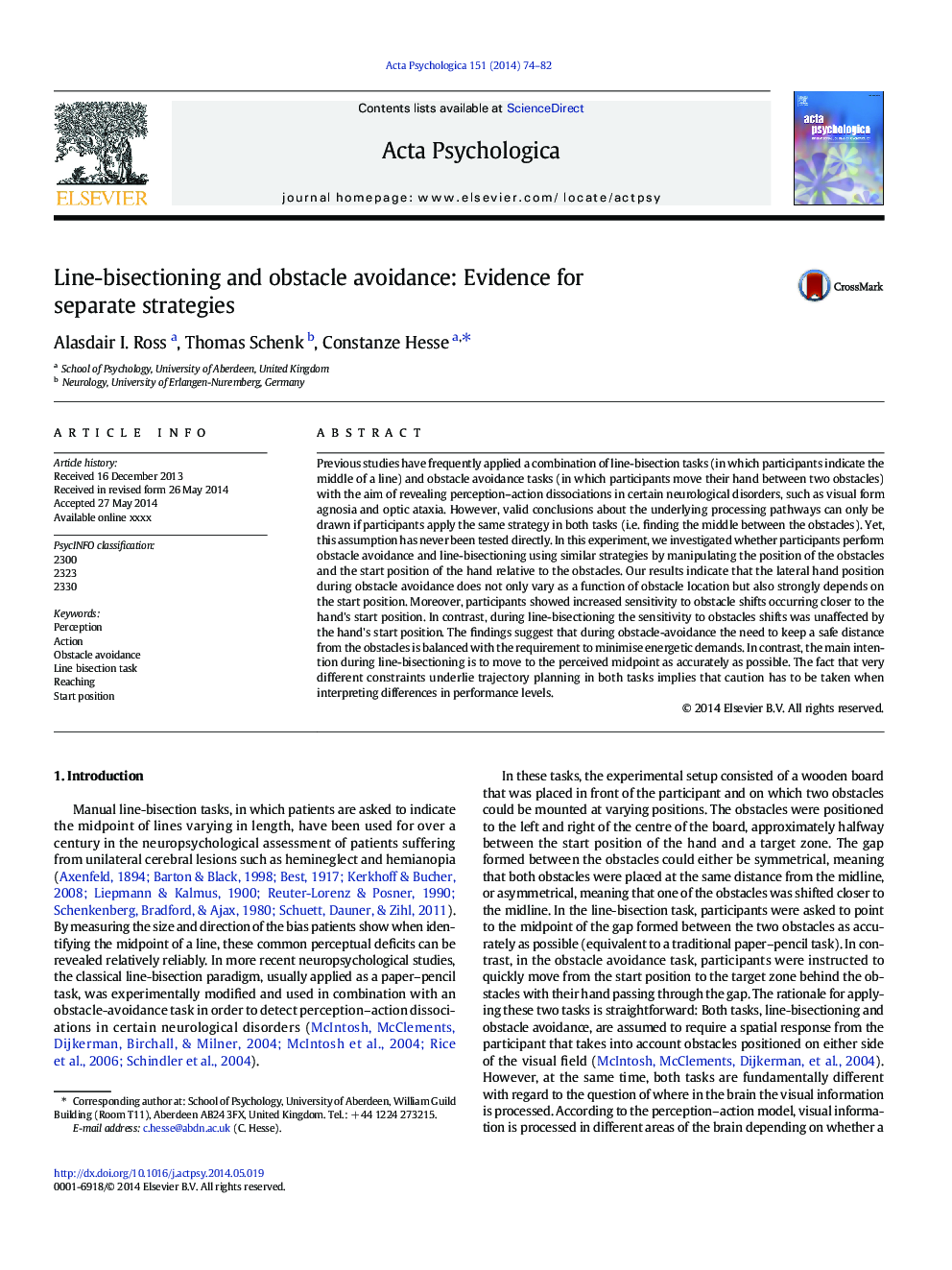| کد مقاله | کد نشریه | سال انتشار | مقاله انگلیسی | نسخه تمام متن |
|---|---|---|---|---|
| 7277551 | 1473607 | 2014 | 9 صفحه PDF | دانلود رایگان |
عنوان انگلیسی مقاله ISI
Line-bisectioning and obstacle avoidance: Evidence for separate strategies
ترجمه فارسی عنوان
تقسیم خط و اجتناب از مانع: شواهد برای استراتژی های جداگانه
دانلود مقاله + سفارش ترجمه
دانلود مقاله ISI انگلیسی
رایگان برای ایرانیان
کلمات کلیدی
2300، 2323، 2330، ادراک، عمل، اجتناب از موانع، وظیفه خط بسکی، دستیابی به، نقطه شروع،
ترجمه چکیده
مطالعات قبلی اغلب ترکیبی از وظایف خطی برش (که در آن شرکت کنندگان نشان دهنده وسط یک خط است) و وظایف اجتناب از مانع (که در آن شرکت کنندگان حرکت خود را بین دو موانع) با هدف آشکار سازی ادراک عمل در برخی از عصبی اختلالاتی مانند آگنوزاییک فرم و آتاکسی نوری. با این حال، نتایج قابل قبول در مورد مسیرهای پردازش زمینه تنها می تواند در صورتی که شرکت کنندگان استراتژی مشابه را در هر دو وظیفه (به عنوان مثال پیدا کردن وسط بین موانع) است. با این حال، این فرضیه هرگز به طور مستقیم مورد آزمایش قرار نگرفته است. در این آزمایش، ما بررسی کردیم که آیا شرکت کنندگان اجتناب از مانع و خط بریدن با استفاده از استراتژی های مشابه را با دستکاری موقعیت موانع و موقعیت شروع دست نسبت به موانع انجام می دهند. نتایج ما نشان می دهد که موقعیت دست در هنگام جلوگیری از موانع نه تنها به عنوان یک عملکرد از موقعیت مانع تغییر می کند، بلکه به شدت به موقعیت شروع بستگی دارد. علاوه بر این، شرکت کنندگان حساسیت بیشتری نسبت به تغییرات مانع که نزدیک به موقعیت شروع دست بودند نشان داد. در مقابل، در حین خط کشیدن حساسیت به تغییرات موانع، موقعیت ابتدایی دست را تحت تاثیر قرار نمی داد. یافته ها حاکی از آن است که در هنگام اجتناب از موانع نیاز به نگه داشتن فاصله ایمن از موانع با نیاز به کاهش نیازهای انرژی منطبق است. در مقابل، قصد اصلی در هنگام خط بریدن، حرکت دادن به نقطه میانی درک شده به همان اندازه دقیق است. واقعیت این است که محدودیت های بسیار متنوع برنامه ریزی مسیر در هر دو وظیفه را شامل می شود، به این معنی است که هنگام تفسیر تفاوت ها در سطوح عملکرد باید احتیاط شود.
موضوعات مرتبط
علوم زیستی و بیوفناوری
علم عصب شناسی
علوم اعصاب شناختی
چکیده انگلیسی
Previous studies have frequently applied a combination of line-bisection tasks (in which participants indicate the middle of a line) and obstacle avoidance tasks (in which participants move their hand between two obstacles) with the aim of revealing perception-action dissociations in certain neurological disorders, such as visual form agnosia and optic ataxia. However, valid conclusions about the underlying processing pathways can only be drawn if participants apply the same strategy in both tasks (i.e. finding the middle between the obstacles). Yet, this assumption has never been tested directly. In this experiment, we investigated whether participants perform obstacle avoidance and line-bisectioning using similar strategies by manipulating the position of the obstacles and the start position of the hand relative to the obstacles. Our results indicate that the lateral hand position during obstacle avoidance does not only vary as a function of obstacle location but also strongly depends on the start position. Moreover, participants showed increased sensitivity to obstacle shifts occurring closer to the hand's start position. In contrast, during line-bisectioning the sensitivity to obstacles shifts was unaffected by the hand's start position. The findings suggest that during obstacle-avoidance the need to keep a safe distance from the obstacles is balanced with the requirement to minimise energetic demands. In contrast, the main intention during line-bisectioning is to move to the perceived midpoint as accurately as possible. The fact that very different constraints underlie trajectory planning in both tasks implies that caution has to be taken when interpreting differences in performance levels.
ناشر
Database: Elsevier - ScienceDirect (ساینس دایرکت)
Journal: Acta Psychologica - Volume 151, September 2014, Pages 74-82
Journal: Acta Psychologica - Volume 151, September 2014, Pages 74-82
نویسندگان
Alasdair I. Ross, Thomas Schenk, Constanze Hesse,
